I n November 2019 Melissa Conn (’87, P ’22) was at her home in the Castello district of Venice — near the city’s medieval arsenal that built the ships that fueled the city’s rise to maritime and economic power — when the wind and rains began. “When the water was rising and the winds picked up, it became ominous,” she recalls. “But nobody had any idea it would be the second highest tide ever.”
In a city used to tidal floods rolling in from the Adriatic Sea, this storm was different. It submerged iconic St. Mark’s Square and 80% of the city, sent corrosive saltwater pouring into ancient churches, and threatened irreplaceable Renaissance art and architecture. It is on record as the second highest acqua alta since 1966.

While the water was still rising, Conn was already planning the restoration work — and there would be a lot of it — which has defined her three decades in Venice to save the city’s endangered artistic and cultural treasures.
“This is what we’re here for, to bring the world’s attention to the fragile nature of the artistic patrimony of Venice,” says Conn, the longtime director of the Venice office of Save Venice. Based in New York, Save Venice is the largest international nonprofit dedicated to preserving the city’s art, architecture, history and culture. Conn’s work took on renewed urgency after the flood.
“In some ways, Venice is one of the wonders of the world. The fact that man created such an incredibly beautiful city, the impossible city built out of the water, makes Venice unlike any place else, and it should be preserved.”
Saving Venice, she says, should matter to all of us, whether we’re Italian or American, whether we’ve been to Venice or not, for all that Venice gives us.
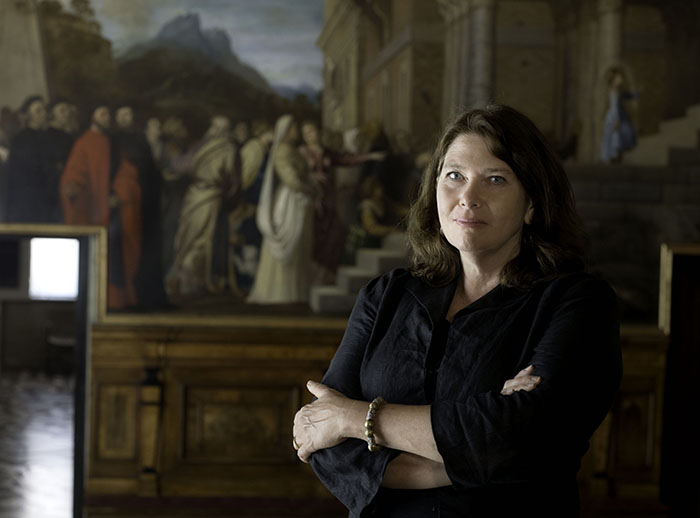
Melissa Conn with Titian's 16th-century “Presentation of the Virgin in the Temple,” restored by Save Venice in 2010-2012, in the Gallerie dell'Accademia.
From her fourth-floor office in the 15th-century Palazzo Contarini Polignac overlooking the Grand Canal, Conn can almost see Wake Forest’s study-abroad center, Casa Artom. It is just a block away, beside the Peggy Guggenheim Collection, but a bend in the canal hinders Conn’s direct view. She had never been out of the United States until she studied at Casa Artom and fell in love with Venice. “It was an incredible experience for art history, and I got the big bug for Italian art.”
Now she’s so thoroughly Venetian that she’s entrusted with overseeing millions of dollars a year, donated primarily by Americans, to preserve her adopted city’s heritage. She links the Save Venice board and the New York home office to Italian government cultural officials, museum directors and conservators.
Save Venice was founded in 1971 after the record-breaking 1966 flood raised awareness of the need to protect the city’s historic art and architecture. (Venice and its lagoon are a UNESCO World Heritage Site.) Since then, the organization has funded the restoration of more than 1,000 individual artworks.
Conn has worked for Save Venice since 1989 and was named director of the Venice office in 1998. An art historian, she oversees several dozen conservation projects a year, primarily of 16th-century art and architecture, in museums, churches and scuole (grand meeting halls for religious confraternities or professional associations). The list of restorations under her care is long and impressive — masterpieces by Renaissance artists Titian and Tintoretto, sculptures, frescos, mosaics, rare books and once, a 1930s gondola, the fourth oldest in Venice.
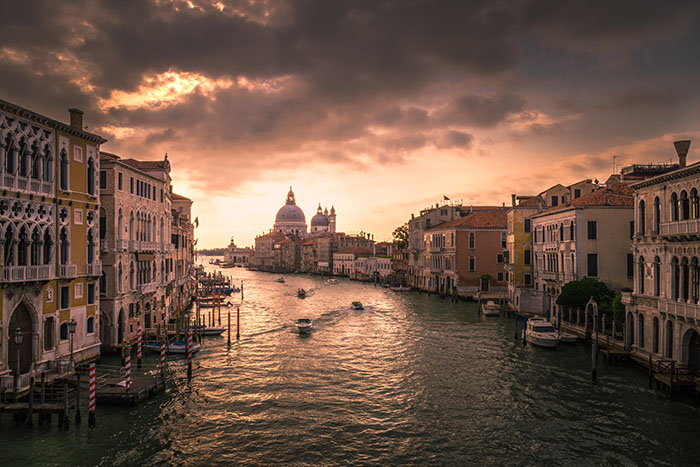
Melissa Conn's office in the Palazzo Contarini Polignac (far right) is a short walk from Casa Artom (center), where she studied as a student.
Save Venice board chair Frederick Ilchman, chair of the art of Europe at the Museum of Fine Arts in Boston, worked with Conn in Venice 20 years ago when he was a doctoral student. “She is respected throughout the city,” he says. “She has a love of Venice and preserving Italian art.”
When we talked by Zoom in mid-May, Conn had just returned from visiting the 16th-century church of San Sebastiano, a short walk from the Save Venice office and its Rosand Library and Study Center. An ongoing 10-year, $5 million restoration has restored the building’s façade, ceiling, walls, floors, and paintings and frescoes by Paolo Veronese. Most recently, work was underway to repair subfloors under the bell tower, damaged in the November flood. It’s the project closest to her heart, both because of the scale of the restoration and the fact that she has overseen it from the beginning.
When I ask Conn what it’s like being an American working to save Venice’s treasures, she hesitates to answer because those lines long ago blurred. She married a Venetian — whom she met when she studied at Casa Artom — and they have two sons with dual American-Italian citizenship. Both sons were born in the city hospital, the Scuola Grande di San Marco, during restoration of the building’s late-15th century façade, Conn’s first major restoration project as director of the Venice office.
Her older son, a Wake Forest junior, is named Sebastiano, which leads me to ask if he is named after the church of San Sebastiano. “No,” she says, laughing. “I knew you were going to ask that. He was born before we started (the restoration). One of the nuns asked me that years ago and said it was my destiny.”

Melissa Conn takes an up-close look at one of Veronese’s three large ceiling canvases, restored by Save Venice in 2009-2011, in the church of San Sebastiano.<br />
Conn grew up in the small Ohio town of Salem, whose most famous son is the late watercolorist Charles Burchfield. (Salem, Ohio, was originally settled by Quakers in the early 1800s, 50 years after Moravians founded the Salem that became part of Winston-Salem.) She remembers being impressed when she was a student intern at Reynolda House Museum of American Art and found a Burchfield painting, “The Woodpecker,” in the museum’s collection.
Her attorney father planted the seed, however small, for her interest in art and history. He often took his three daughters — Conn is the middle child — to art museums and historical sites when they were growing up. Childhood trips to beaches in Maine and Delaware led her to dream of being a marine biologist. That changed when Conn’s high school English teacher showed students slides of her summer vacation in Europe. Conn was captivated by the teacher’s photographs of canals and Renaissance architecture in Venice.
When she learned that Wake Forest had a study-abroad program in Venice, she found her college home. She found her major — and, as it turned out, eventually her career — during an art history class with Professor of Art Harry Titus, although at the time her tastes in art ran more to American than Venetian. “I’ve always had an interest in art, but the fact that you could actually study it in art history … the combination of history, art, the social and political background of what was happening when something was created, I found interesting,” she says.
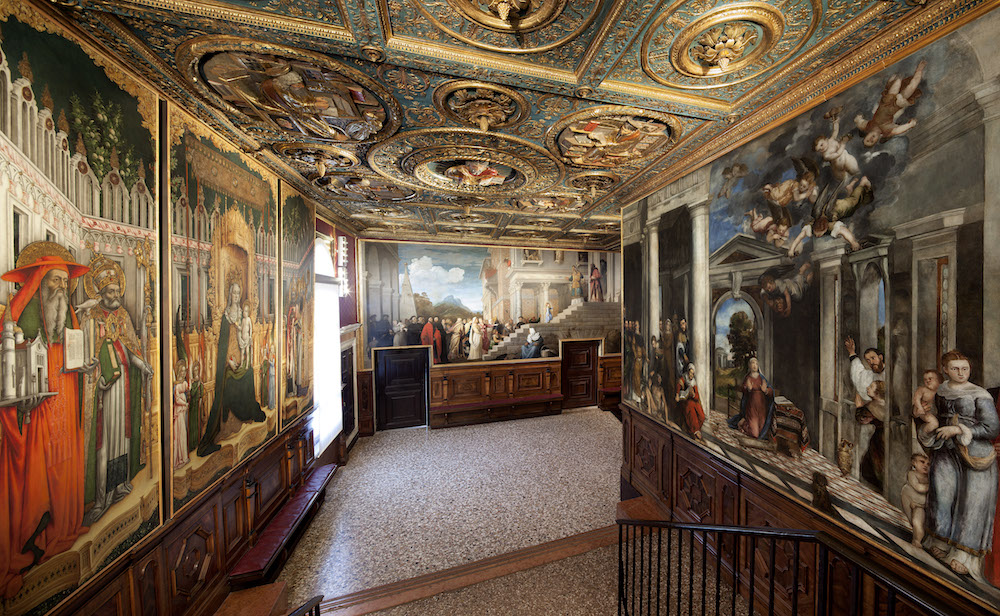
Titian's 16th-century “Presentation of the Virgin in the Temple,” restored by Save Venice in 2010-2012, in the Gallerie dell'Accademia.
As a senior, she spent the fall semester at Casa Artom with Titus. While most of her classmates traveled to other parts of Italy and Europe over long weekends, she stayed in Venice to immerse herself in the city’s culture and history. She also met an Italian architecture student, Fabrizio Tibolla, whom she would marry in 1993. When she returned to Wake Forest for her last semester, she couldn’t wait to get back to Venice.
“Just for a year,” she kept telling her parents.
After graduating, she worked at the Smithsonian American Art Museum in Washington, D.C., before returning to Venice as an au pair. There, she started volunteering with Save Venice, which in a strange twist led her back to the United States to work in Save Venice’s home office in New York. In 1989, she moved to Venice to stay.
“It’s inspiring to watch Melissa lead students through a church or museum that is full of masterpieces of art, all restored through the sponsorship of Save Venice. She can weave in the history of that neighborhood in Venice, the building's construction, the paintings and sculptures that decorate the interior, past conservation treatments of these works and, finally, the restorations.”
She had always planned to return to school to earn a master’s or Ph.D. in art history but between raising her two sons and working at Save Venice, she never found the time, making her something of a rarity in the world of art historians. Instead, she says, she earned her advanced degree “on the streets of Venice.”
In every corner of the city, she finds connections with the people who once lived there. “You have this real sense of history that you’re surrounded by the places where artists and musicians lived and worked. I live near the church where (Baroque composer) Antonio Vivaldi was baptized and a five-minute walk from where he worked. When I walk to the church that houses Paolo Veronese’s paintings, he (Veronese) walked the same way to the church.”
Titus, who’s now retired, has visited Conn in Venice and says that her nontraditional path is to her credit. “She has had as interesting a career as any of our students who went on to graduate school because she’s been hands-on with the work all this time. The work she has been involved with over the years has been spectacular.”
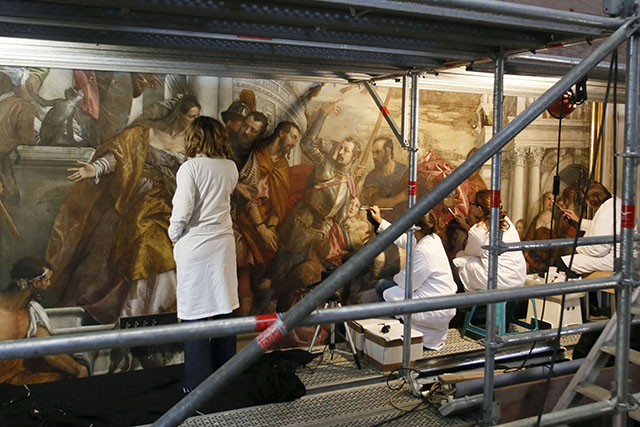
Conservators restore a 16th-century Veronese painting, Conn’s favorite painting, in the church of San Sebastiano.<br />
For those who live in Venice, they have to love the water, even though it constantly threatens the city they love. “Water is the reason why Venice is here, so the people could escape the barbarians on the mainland. There were no fortress walls; the water protected them,” Conn explains. “Water is what made the Venetians wealthy … through the salt trade and then as merchants and shipbuilders at the arsenal, which had the first assembly lines for ships. It’s the blood of Venice, the lifeline of Venice.”
And residents must learn to live with floods. But the floods of past years are becoming more frequent and severe, even as the city struggles to complete a multibillion dollar, oft-delayed 20-year project to install massive floodgates in the Venetian Lagoon. Last November’s near record-breaking flood wasn’t a one-day event but several floods that lasted into December.
After that first night of wind and rain, Conn pulled on her hip boots, grabbed mops and buckets, and went to work. With colleagues, volunteers and her younger son, Lorenzo, she mopped up corrosive saltwater from marble floors in the 15th-century Ca’ d’Oro museum on the Grand Canal and helped priests and nuns load waterlogged debris from San Sebastiano onto barges to be carried away.

Save Venice volunteers mop up saltwater in the 16th-century church of San Sebastiano after the November 2019 flood. Save Venice has restored the church’s ceiling, walls, floors, front and side façades, and paintings and frescoes by Paolo Veronese.
“It was a very American thing to do,” she says of her immediate efforts to help stem the damage. “I couldn’t just stand there and watch and say, ‘We’re going to give you money.’ Save Venice isn’t just about (raising) money. We’re here to give moral support, too.”
Save Venice launched an emergency fund to respond to the widespread damage. Supported by the Italian Embassy in Washington, D.C., the fund raised more than $700,000 from donors in the United States and Italy. In the days that followed, Save Venice installed pumps and flood barriers, shored up damaged stone walls and floors, and cleaned mosaic and marble floors.
Emergency restoration work began at some two dozen sites, including the ninth-century church of Santa Maria Assunta on the island of Torcello in the Venetian lagoon and the 15th-century Scuola Dalmata di San Giorgio degli Schiavoni, once the meeting hall for immigrants from Dalmatia, now part of Croatia.
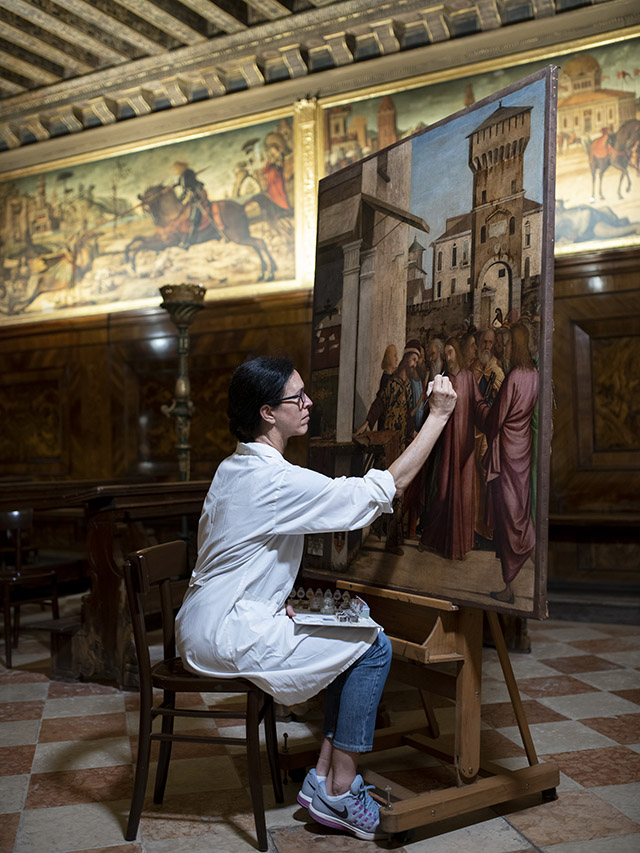
A conservator works on a painting by Vittore Carpaccio, one of the paintings that wrap around the walls of the 15th-century Scuola Dalmata di San Giorgio degli Schiavoni.
The next storm arrived in February, but this one was a pandemic. Conn had just wrapped up Save Venice’s three-day masquerade ball, The Carnevale Gala, which raised more than $500,000. Then COVID-19 began spreading across Italy. The Italian government issued strict stay-at-home orders, shutting down Save Venice’s conservation projects.
Conn was scheduled to lecture at Casa Artom, but Wake Forest students studying there were sent home in late February. When Wake Forest closed the Reynolda Campus in mid-March, Conn’s older son, Sebastiano, couldn’t return to Italy, so he went to live with Conn’s sister’s family in Ohio. Conn and her husband decamped to the mountain town of Agordo for the weekend and ended up staying for two months. They returned to a different city in May. The tourists were gone, shops and restaurants closed, and boat traffic on the city’s main thoroughfare, the Grand Canal, had slowed to a trickle.
Her 20-minute walk from her home to her office — she prefers walking to taking the vaporetto water bus — is different, too. The canals are cleaner, and the city is quieter, more walkable and livable. As she walks past the Doge’s Palace and St. Mark’s Basilica, past shuttered tourist shops and docked gondolas, and over the Ponte dell’Accademia bridge, she can, once again, fully appreciate the beauty of the city that she fell in love with as a student.
“You can see the architecture and the buildings without worrying about tripping over someone,” she says. “You’re much more aware of the reflections on the Grand Canal, because before the boats stirred up silt from the bottom. There’s much more wildlife. We don’t normally have ducks, and now there are colonies of ducks. Fish are more noticeable because they’re not being disturbed by the boat traffic.”
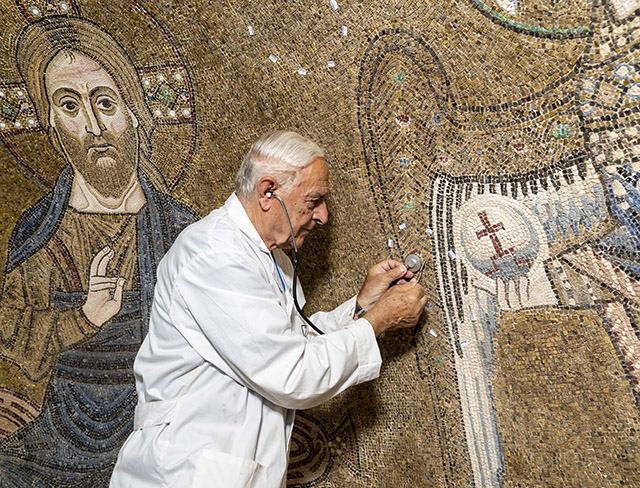
A conservator listens for hollow sounds as he taps on an 11th-century mosaic at the ninth-century church of Santa Maria Assunta. A hollow sound denotes that there is space between the wall and the mosaic, meaning that the conservator will inject consolidating agents to re-adhere the mosaic layer to the brick wall that supports it. <br />
With fewer tourists, Venice has a chance to reinvent itself to become a living city again, Conn says. She’s hoping that more Italians, especially students and young people, will be able to afford to live in the city. The millions of tourists who annually visit the city — pre-COVID-19 — overwhelm the city’s population, which has declined from about 170,000 in 1950 to 53,000 today.
Before a Zoom call in mid-June, Conn had just returned from the church of Santa Maria Assunta on Torcello. There she met with conservators who are restoring the church’s ninth-century walls and 11th-century mosaics, the oldest remaining in Venice. “I really like being in touch with the artworks,” she says of her frequent site visits to meet with architects, conservators and Italian art historians. “Being on a scaffolding or being with restorers or conservators is the most inspiring part of my job.”
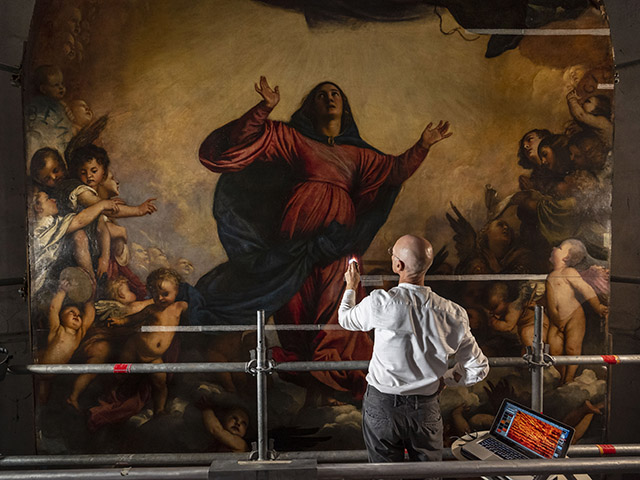
Titian's 500-year-old “Assumption of the Virgin” at the church of the Frari.
In the heat of the Venetian summer, Conn was already looking ahead to Save Venice’s 50th anniversary in 2021. She’s overseeing $5 million for 48 conservation projects in the next year alone. Work has already begun on restoring the 16th-century Italian Synagogue in the Venetian Ghetto, five centuries ago the first segregated, walled quarter for Jews in Europe. Restoration work is also underway at the church of the Frari on Titian’s 500-year-old “Assumption of the Virgin,” thought to be the largest painting on wood in the world. Conservators are scrambling to finish as much work as they can while tourists are gone and before the floods inevitably come again this fall.
For an American devoted to saving Venice’s past from the ravages of pollution, climate change, more frequent floods, too many tourists and simple old age, Conn is optimistic. “I have to be. Venice has been through so many floods, plagues and wars. The fall of the republic, the French occupation, the Austrian occupation. Yes, sea levels are rising, but we’ll just keep adapting. That’s what’s always been done.”
Saving one of the world’s great cities isn’t only about the past; it’s also about the future, she says. “Art and beauty matter, and you want those things in your life. Remembering what a city has been in the past can make the future a little brighter because you’re not giving up.”
“Save Venice, with the best art restorers and experts in conservation and art history, has been taking care of, like a mother with her children, the treasures of Venice. It is love for the buildings, the paintings and all that witnesses the grandiose past of Venice. It’s an act of love of Americans for the city, its treasures and an act of civilization, ‘Pro Humanitate' at work.”
Wake Forest’s Venice Connection
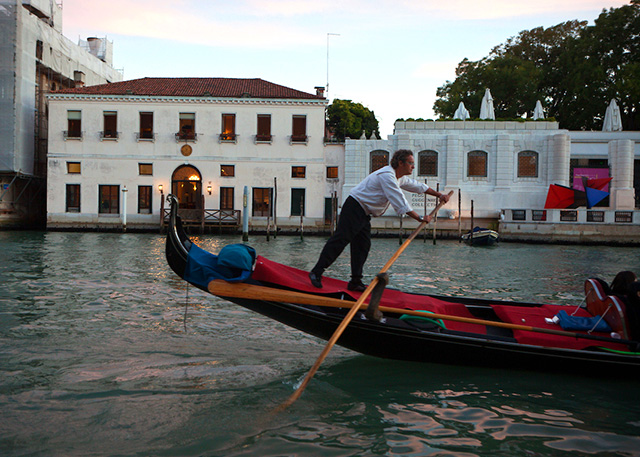
When Wake Forest decided in the early 1970s to start a study-abroad program, then-President James Ralph Scales looked first to Italy. Scales was fond of quoting poet Robert Browning: “Open my heart and you will see/ Graved inside of it ‘Italy.’ ”
In 1971, the University leased an 1828 palazzo, a former American Consulate on the Grand Canal in Venice, with help from then-U.S. Ambassador to Italy Graham Martin (’32, LL.D. ’69). (Martin had previously served as ambassador to Thailand and would later serve as the last United States ambassador to South Vietnam.) The first nine students to study at “the Venice house” arrived in fall 1971 with John Andronica (P ’89, ’92), then an assistant professor of classical languages and literature.
Three years later, the University purchased the house for $250,000 from the U.S. government. The house was named Casa Artom in honor of the late Dr. Camillo Artom, a prominent Italian biochemist who fled Italy in the late 1930s. After coming to the United States, he taught at the School of Medicine until retiring in 1961. He was the first recipient of the University’s Medallion of Merit, in 1969.
Artom’s wife, Bianca, served as Casa Artom’s summer director and taught Italian language and literature on the Reynolda Campus from 1975 until retiring in 1990. Following her death in 1994, she was recognized as the founder of the Venice program and honored in the name of the house.
Since 1971, about 2,000 undergraduates have spent a semester at Casa Artom, and several hundred undergraduates and law students have studied there in the summers. Because of COVID-19, the program is suspended this fall.



